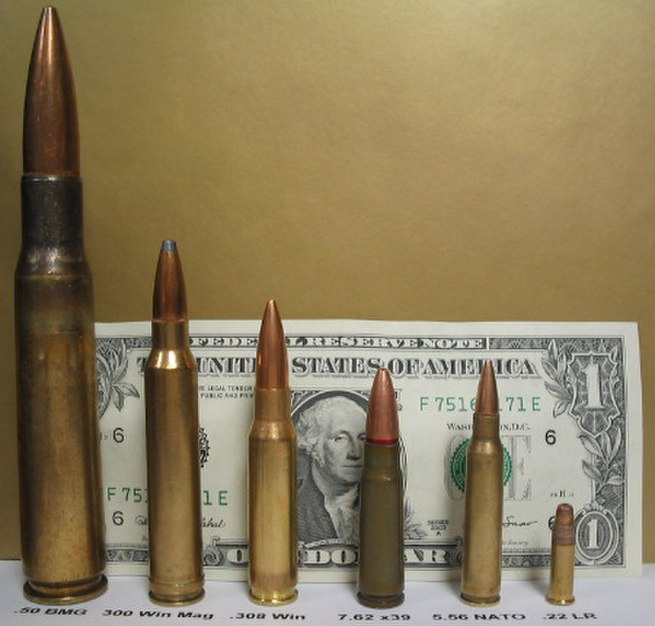
-
Caliber
In guns, particularly firearms, caliber or calibre is the approximate internal diameter of the gun barrel, or the diameter of the projectile it shoots. It is measured in hundredths or thousandths of an inch or in millimetres. For example, a “.45 caliber” firearm has a barrel diameter of roughly 0.45 inches (11 mm). Barrel diameters can also be expressed using metric dimensions. For example, a “9mm pistol” has a barrel diameter of about 9 millimetres (it is rare for the actual barrel diameter to precisely match the designation however, and the bullet itself is yet another dimension). When the barrel diameter is given in inches, the abbreviation “cal” (for “caliber”) can be used. For example, a small-bore rifle with a diameter of 0.22 inches (5.6 mm) can be referred to as “.22” or a “.22 cal”; however, the decimal point is generally dropped when spoken, making it a “twenty-two” or a “two-two caliber”, or a “.45 caliber” would be a “forty-five”, or “forty-five caliber”, etc.
In a rifled barrel, the distance is measured between opposing lands or grooves; groove measurements are common in cartridge designations originating in the United States, while land measurements are more common elsewhere in the world. Good performance requires a bullet to closely match the groove diameter of a barrel to ensure a good gas seal and hence maximal bullet propulsion.
While modern firearms are generally referred to by the name of the cartridge the gun is chambered for, they are still categorized together based on bore diameter. For example, a firearm might be described as a “30 caliber rifle”, which could be any of a wide range of cartridges using a roughly 0.30 inches (7.6 mm) projectile; or a “22 rimfire”, referring to any rimfire firearms firing cartridges with a .22 caliber projectile.
Firearm calibers outside the range of .17–.50 inches (4.3–12.7 mm) exist, but are rarely encountered. Wildcat cartridges, for example, can be found in .10, .12, and .14 cal (2.5, 3.0, and 3.6 mm), typically used for short-range varmint hunting, where the high-velocity, lightweight bullets provide devastating terminal ballistics with little risk of ricochet. Larger calibers, such as .577, .585, .600, and .700 (14.7, 14.9, 15.2, 17.8 mm) are generally found in proprietary cartridges chambered in express rifles or similar guns intended for use on dangerous game. The .950 JDJ is the only known cartridge beyond 70 caliber used in a rifle.
Referring to artillery, “caliber” is used to describe the barrel length as multiples of the bore diameter. A “5-inch 50 calibre” gun has a bore diameter of 5 in (12.7 cm) and a barrel length of 50 times 5 in = 250 in (6.35 m). The main guns of the USS Missouri (Iowa Class Battleship) are 16″ 50 caliber.
In shotguns, each gauge of shotgun has a set caliber. For example, a 12 gauge shotgun has a caliber of 18.53 mm or .729 inches.
-
Caliber (noun)
standard spelling of calibre|from=American spelling
-
Caliper (noun)
Uncommon variant of calipers.
-
Caliper (noun)
The part of a disc brake that holds the brake pads.
-
Caliper (noun)
an instrument for measuring external or internal dimensions, having two hinged legs resembling a pair of compasses and in-turned or out-turned points.
-
Caliper (noun)
a measuring instrument having one linear component sliding along another, with two parallel jaws and a vernier scale.
-
Caliper (noun)
a motor-vehicle or bicycle brake consisting of two or more hinged components.
-
Caliper (noun)
a metal support for a person’s leg.
